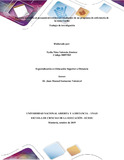Mostrar el registro sencillo del ítem
Factores asociados al pensamiento crítico en estudiantes de un programa de enfermería de la costa Caribe
| dc.contributor.advisor | Santacruz Valcárcel, Juan Manuel | |
| dc.coverage.spatial | ccav_-_sahagún | spa |
| dc.creator | Valencia Jiménez, Nydia Nina | |
| dc.date.accessioned | 2019-11-02T14:47:15Z | |
| dc.date.available | 2019-11-02T14:47:15Z | |
| dc.date.created | 2019-11-01 | |
| dc.identifier.uri | https://repository.unad.edu.co/handle/10596/28345 | |
| dc.description.abstract | Estudio descriptivo transversal con enfoque cualitativo, que buscó analizar el pensamiento crítico asociado a estudiantes de enfermería de una institución de educación superior de la costa Caribe. Se empleó el estudio de caso, observación participante y los grupos focales a 30 estudiantes matriculados en el cuarto, sexto y octavo semestre de la carrera, que fueron seleccionados mediante la técnica no probabilística por conveniencia, cuya muestra se obtuvo a partir del punto de saturación teórica. Se evalúo el pensamiento crítico a partir de identificar cuatro habilidades del pensamiento referidas a la claridad, certeza, relevancia y lógica. En el punto de claridad, las respuestas de los tres grupos se conservó homogénea; en lo que respecta a la certeza, se destacaron las respuestas de los estudiantes de cuarto semestre por encima de los de sexto y octavo, particularmente en el cuestionamiento de la exclusividad del conocimiento científico al momento de resolver una situación, entre tanto, los estudiantes de octavo semestre demostraron mayor nivel de pensamiento crítico al considerar que las creencias podrían limitar la atención en salud; en lo que tiene que ver con la relevancia, no se observó diferencias significativas; y en el ámbito de la lógica, se observó diferencias en el punto que evalúa la capacidad de compartir y socializar los saberes, frente al cual los estudiantes matriculados en octavo semestre muestran menores niveles de pensamiento crítico. Los estudiantes consideran que los maestros, familia, estereotipos y la religión son las principales barreras que tienen que enfrentar para pensar por sí mismos, considerando que cuando se encuentran ante manifestaciones estudiantiles experimentan cierto grado de libertad porque pueden decir lo que piensan e integrarse con otros compañeros; frente a lo cual propusieron que la estrategias que se han de implementar es la inclusión de otros cursos en el ámbito de las humanidades y electivas que les permita expresarse libremente, así como también, lograr niveles de pensamiento crítico que minimicen la competencia, el miedo y la represión. El estudio concluyó que no encontraron diferencias marcadas entre los diferentes grupos de estudiantes matriculados observándose un buen nivel de pensamiento crítico, sin embargo, los grupos focales señalan inconformismo ante las barreras que impone la sociedad, familia y universidad para pensar por sí mismo, y logran identificar como estrategia central la potenciación de espacios para la formación integral y la sana convivencia. | spa |
| dc.format | ||
| dc.format.mimetype | application/pdf | spa |
| dc.language.iso | spa | spa |
| dc.publisher | Universidad Nacional Abierta y a Distancia UNAD | spa |
| dc.title | Factores asociados al pensamiento crítico en estudiantes de un programa de enfermería de la costa Caribe | |
| dc.type | Proyecto de investigación | |
| dc.subject.keywords | Pensamiento crítico | spa |
| dc.subject.keywords | Empoderamiento | spa |
| dc.subject.keywords | Educación superior | spa |
| dc.description.abstractenglish | Descriptive cross-sectional study with a qualitative approach, which sought to analyze the critical thinking associated with nursing students of a higher education institution on the Caribbean coast. The case study, participant observation and focus groups were used on 30 students enrolled in the fourth, sixth and eighth semester of the degree, who were selected using the non-probabilistic technique for convenience, whose sample was obtained from the saturation point theoretical Critical thinking was evaluated based on identifying four thinking skills related to clarity, certainty, relevance and logic. At the point of clarity, the responses of the three groups remained homogeneous; With regard to certainty, the answers of the fourth semester students were highlighted above those of the sixth and eighth, particularly in the questioning of the exclusivity of scientific knowledge when solving a situation, meanwhile, the students of Eighth semester demonstrated a higher level of critical thinking when considering that beliefs could limit health care; in what has to do with relevance, no significant differences were observed; and in the field of logic, differences were observed in the point that assesses the ability to share and socialize knowledge, compared to which students enrolled in the eighth semester show lower levels of critical thinking. Students consider that teachers, family, stereotypes and religion are the main barriers they have to face to think for themselves, considering that when they face student demonstrations they experience a certain degree of freedom because they can say what they think and integrate with others. companions; against which they proposed that the strategies to be implemented is the inclusion of other courses in the field of humanities and electives that allow them to express themselves freely, as well as achieve critical thinking levels that minimize competition, fear and the repression. The study concluded that they did not find marked differences between the different groups of students enrolled, observing a good level of critical thinking, however, the focus groups indicate nonconformity before the barriers imposed by society, family and university to think for themselves, and achieve Identify as a central strategy the strengthening of spaces for integral formation and healthy coexistence. | spa |
| dc.subject.category | Educación, enfermería | spa |
| dc.rights.accesRights | info:eu-repo/semantics/openAccess | spa |
| dc.rights.acceso | Abierto (Texto Completo) | spa |















